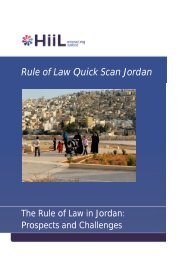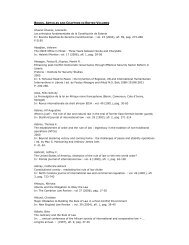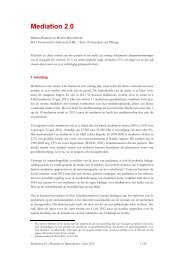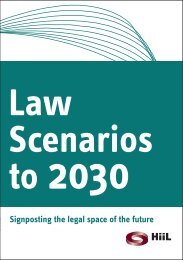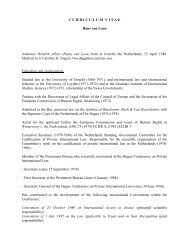Trend Report | Part 1 - HiiL
Trend Report | Part 1 - HiiL
Trend Report | Part 1 - HiiL
Create successful ePaper yourself
Turn your PDF publications into a flip-book with our unique Google optimized e-Paper software.
2.1 At Least One Serious Problem in 5 to 10 Years<br />
Traditionally, legal needs have been estimated through analysis of the use of legal services and judicial<br />
institutions. The number of disputes that are resolved by courts, arbitration panels or mediators have<br />
been used to illustrate the levels of disputes in the society. Or the number of issues leading to private<br />
legal advice or state funded legal aid can be used as indication of legal needs. Finally, legal needs might<br />
be estimated through the amount of public resources invested in official and unofficial dispute resolution<br />
processes. 41<br />
But many problems never reach courts or these sources of legal advice. Furthermore, bare statistics do<br />
not tell us what the alternatives to official justice are. Do people bury their problems because they<br />
cannot reach courts or do they get access to justice by other means?<br />
Since the 1970s the legal needs of the people are estimated in a radically different approach. Looking for<br />
ways to improve legal aid systems, researchers collect evidence about met and unmet legal needs. The<br />
so called ‘justiciable events’ approach focuses on people and their experiences to portray how law affects<br />
their everyday life. 42 A justiciable problem is not a legal term. It is a recognizable situation from life,<br />
described in comprehensible language, which has a legal solution but can also be resolved through other<br />
means (such as a simple discussion between the parties).<br />
Not all problems with potential legal solutions are justiciable. Many situations are trivial and should not<br />
be regarded as problems that have to be solved with legal means. So research into legal needs tends to<br />
be limited to problems with a certain level of intensity.<br />
What all legal needs studies find is that many people experience difficult legal problems, but the<br />
proportions vary greatly. In 2003, 67,5% of the interviewed individuals in the Netherlands reported<br />
experience with at least one serious and difficult to resolve legal problem for the last 5 years. 43 Six years<br />
later, 60,5% of Dutch respondents reported that they had to deal with a justiciable problem. 44<br />
A lower incidence of legal problems is reported in studies from the US (50%) 45 and New Zealand (51%) 46<br />
despite the fact that these studies covered more problems or asked for household experience as opposite<br />
to individual experiences. Studies from Canada 47 (44,6%), Russia 48 (31%), Ukraine 49 (54%) and<br />
Bulgaria 50 (46,3%) find that about half of all respondents recall at least one serious and difficult to<br />
resolve legal problem.<br />
41 An excellent comparative overview of such input data is assembled every 2 years by the European Commission on<br />
the Efficiency of Justice (CEPEJ), see www.cepej.org.<br />
42 Hazel Genn defines justiciable event as “a matter experienced by a respondent which raised legal issues, whether or<br />
not it was recognized by the respondent as being “legal” and whether or not any action taken to deal with the event<br />
involved the use of any part of the civil justice system.” See below footnote 51 at p. 12<br />
43 Van Velthoven, B. C. J., & ter Voert, M. 2004. Paths to Justice in the Netherlands. Looking for signs of social<br />
exclusion. In K. Caminada, & B. C. J. van Velthoven (Eds.), Department of Economics Research Memorandum 2004.04:<br />
28. Leiden: Leiden Univesity.<br />
44 Van Velthoven, B. C. J., & Klein Haarhuis, C. M. 2010. Geschilbeslechtingsdelta 2009. Over verloop en afloop van<br />
(potentieel) juridische problemen van burgers. Den Haag: Boom Juridische Uitgevers.<br />
45 American Bar Association, Consortium on Legal Services and the Public, “Legal Needs and Civil Justice. A Survey of<br />
Americans”, Chicago (1994)<br />
46 Maxwell G. et al. “Meeting Legal Needs”, New Zealand: Legal Services Board (1999)<br />
47 Currie, A. 2010. The Legal Problems of Everyday Life The Nature, Extent and Consequences of Justiciable Problems<br />
Experienced by Canadians: Department of Justice, Canada, available at http://www.justice.gc.ca/eng/pi/rs/reprap/2007/rr07_la1-rr07_aj1/toc-tdm.html<br />
48 Study conducted by PILnet Russia, report on file with the authors<br />
49 Study conducted by International Renaissance Foundation Ukraine, report on file with the authors<br />
50 Gramatikov, M. “Multiple Justicable Problems in Bulgaria” Tilburg University Legal Studies Working Paper No.<br />
16/2008.<br />
<strong>HiiL</strong> <strong>Trend</strong> <strong>Report</strong> – <strong>Part</strong> 1: Challenges and Promising Approaches 27




